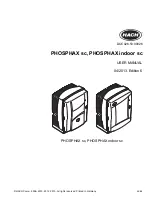
4-1
IM 253421-01E
Setting Measurement Conditions and Measurement Range
4
4.1
Selecting the Measurement Mode
Keys
DC
SCALING
AVG
FILTER
STORE
RECALL
HARMONICS
M W
h
k
A
h
m V
Hz
M W
k
A
deg
var
TIME
FUNCTION
AUTO
MODE
TRIG
MAX HOLD
HOLD
CAL
INTEGRATOR
HARMONICS
INTERFACE
OUTPUT
SHIFT
REMOTE
MEMORY
INTEG SET
ENTER
A RANGE
V RANGE
START
LOCAL
SETUP
STOP
RESET
AUTO
FUNCTION
FUNCTION
m V
PF
M W
k
A
m V
VA
V MEAN
RMS
A OVER
V OVER
SAMPLE
A
B
C
MODE
Displays
relevant
keys and
indicator
Procedure
RMS
V MEAN
DC
MODE
V RANGE
SHIFT
MODE
V RANGE
SHIFT
MODE
V RANGE
SHIFT
Explanation
Measurement Mode
One of the following measurement modes can be selected for measurement of voltage
and current. The initial value is “RMS”.
Indicator Voltage
Current
RMS
Measures and displays true
Measures and displays true RMS
RMS value
value
V MEAN Displays rectified mean value
Measures and displays
calibrated to the RMS value
true RMS value
DC
Displays DC value obtained by
Displays DC value obtained by averaging the input
averaging the input signal
signal
Theoretical Equations
• RMS
This mode is selected to display input voltage or current as a true RMS value.
1
T
0
T
f (t)
2
dt
f (t): input signal
T: one period of the input signal
• V MEAN
This mode is selected to display input voltage or current as a rectified mean value
calibrated to the RMS value. Since a sine wave is used for calibration, the value
displayed will be the same as that obtained in RMS mode if a sine wave is
measured. The value displayed will be different from that obtained in RMS mode if
a distorted or DC waveform is measured.
π
2 2
•
1
T
T
1
f
(t )
dt
f (t): input signal
T: one period of the input signal
• DC
This mode is selected when the input voltage or current is DC. The input signal is
averaged and the result is displayed.
Chapter 4 Setting Measurement Conditions and Measurement Range
















































